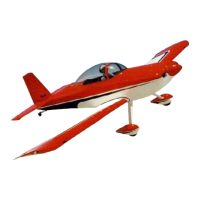PAGE REVISION: DATE:
VAN'S AIRCRAFT, INC.
PAGE REVISION: DATE:
2
RV-ALL05-10
04/15/13
For adjusting buldged trailing edges fabricate a
squeezing tool like the one shown in Figure 4. Join
two 1X2X6 hardwood blocks with wire springs made
from welding rod or left over hinge pin. The wire will
help maintain the block's alignment. Note the
shallow radius formed at each end so that the sharp
edge at the end of the block will not put a crease in
the skin.
To add additional bend (remove buldge), position
the tool as shown in Figure 5 then squeeze the
trailing edge (TE) using large channel-lock pliers.
Large channel-locks provide a lot of leverage which
allows for very fine control.
Apply many small squeezes moving the tool at least
an inch or so after each one. Work back and forth
along the TE checking the skin often with a straight
edge and adjusting local areas as needed until the
entire control surface is uniformly flat. Occasionally
it is difficult to completely finish the bend in areas
where stiffeners or ribs are located.
Correct, or "un-squeeze", an over-bent TE using
another wood block as shown in Figure 6. Again,
put a large radius taper on each end of the block as
was done on the squeezing tool.
Move the tool back and forth along the TE of the
over-squeezed area while lightly taping with a
hammer. If no change results... tap a little bit harder.
It is best to do this adjusting before the control
surfaces are painted because some paints are hard
and can crack from the flexing. If adjustments are
needed on surfaces that have been painted glue
thin felt to the wood blocks to protect the paint
finish.
FIGURE 4: TRAILING EDGE TOOL
FIGURE 5: TRAILING EDGE TOOL APPLICATION
FIGURE 6: "UN-SQUEEZING"
5.7 FOLDED TRAILING EDGES (continued)
After riveting the stiffeners in place and bending the skins,
check that both sides of the skin are flat and form a straight
line from the spar to the tangent point of the trailing edge
radius. Avoid bulged or over-bent trailing edges. See Figures
1-3.
FIGURE 1: BULGED (UNDER BENT) TRAILING EDGE
FIGURE 2: PROPERLY BENT TRAILING EDGE
FIGURE 3: OVER BENT TRAILING EDGE

